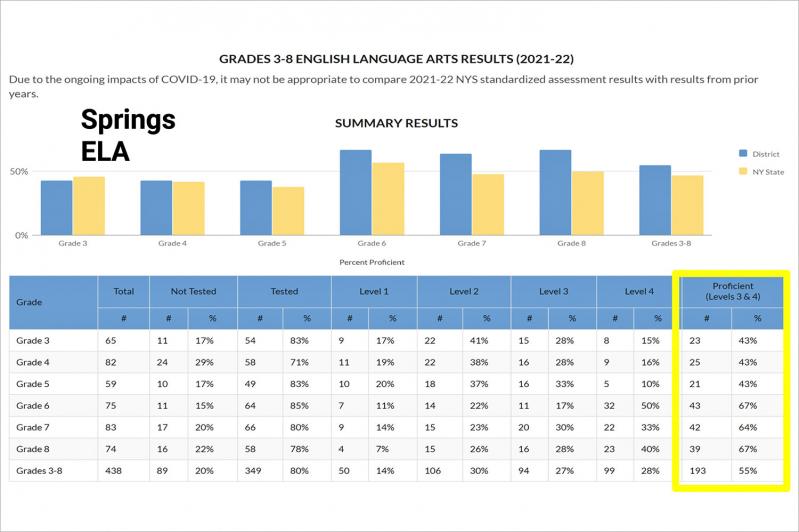Christine Cleary, principal of the Springs School, has done a deep dive into the data surrounding her students’ proficiency levels in English and math. Two conclusions emerged, she reported to the school board and a room full of parents during a Feb. 28 board meeting.
The first is that Springs students are meeting or exceeding New York State average proficiency levels in those two subject areas, but that they are lagging behind their peers in neighboring school districts to varying degrees.
The second conclusion? “There is a direct correlation with expenditures per pupil and performance on state tests,” Ms. Cleary said, referring to the ways in which other East End districts outspend Springs on academics and support programs that have seemingly led to higher test scores.
The Springs School District spends $28,972 per pupil, according to the New York State Education Department’s “school report card” database. Springs is classified as a district with “average need,” with students whose needs are “significantly less than the state average,” and with an ability to raise money through taxes that is “significantly more than the average district in the state.”
Springs’s per-pupil dollar amount is among the lowest on the East End, Ms. Cleary said. The lowest is Hampton Bays, which spends $22,858, and which posted test scores below state averages in several grade levels. The East Hampton School District spends $32,102 per pupil, and the Montauk School $62,340. Both of those districts outperformed Springs students on the state tests.
Per-pupil spending is one factor the state is looking at when it decides how to allocate education dollars, Ms. Cleary said, but she noted that it’s not an entirely accurate snapshot. (It’s also somewhat out-of-date: The numbers presented reflect the state’s most current data, but are actually based on the 2020-21 school year.) The district also already has the highest school-tax rate of any in East Hampton Town.
“We know that we have deep needs in this community,” she said.
Because the district doesn’t serve breakfast and lunch in a traditional cafeteria, as many districts here do, Springs is unable to capture accurate data on students who would qualify for the federal free and reduced-price lunch program. But administrators pointed to its informal, donor-funded lunch cart, Susan’s Lunch Drawer, which provides food for kids who are unable to take lunch to school, as an example of how it fills needs that go underreported.
As far as the actual test scores went, in the 2021-22 school year, Springs kids’ proficiency levels in English came in at 43 percent for the third, fourth, and fifth grades; 64 percent for the seventh grade, and 67 percent for the sixth and eighth grades. Tests are scored on four levels, with Level 3 considered proficient for a student’s grade and Level 4 considered above proficient.
Math scores get a little trickier because many eighth graders are enrolled in a Regents-level algebra course. Just 20 percent of Springs fifth graders scored at or above proficiency levels. In third grade, it was 28 percent scoring at or above proficiency; 33 percent in fourth grade; 42 percent in sixth grade; 32 percent in seventh grade, and 45 percent in eighth grade. All 21 of the Springs eighth graders enrolled in Regents-level math passed their exams, for a 100-percent proficiency rate.
“Of course our goal is 100 percent, but according to the state, we’re not that far behind or we’re above where New York State is performing,” Ms. Cleary said.
A week later, during a March 7 budget workshop, Ms. Cleary’s presentation on test scores and per-pupil spending served as a backdrop to proposed budget increases. Springs is proposing adding $360,000 to the instructional budget, which would include promoting a part-time elementary Spanish teacher to full-time, adding another part-time guidance counseling position, adding two full-time special-education teachers, and planning for the hiring of one more classroom teacher based on enrollment needs.
District administrators have said they are trying to identify “needs” and “wants” to develop spending priorities, while parents have said they are eager to help Springs explore new fund-raising and grant-writing possibilities.
“I think the needs-wants language is a little tricky for parents and teachers who see everything as a need, of course,” Casey Dalene, a parent of two, said during the March 7 meeting. “And I know we can’t afford all our needs at the Spring School. What needs take priority over other needs?”
Springs, which unexpectedly lost its business administrator to an UpIsland district in December, has not yet released a projected budget total for the 2023-24 school year. Instead it seems to have found itself playing catch-up on its budget, as Michael Henery, who had retired in June 2022, stepped back into the role on an interim basis. In addition to its regularly scheduled meeting on Tuesday, the school board has added another budget workshop on March 28; both begin at 7 p.m.

